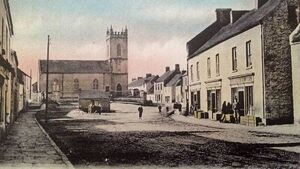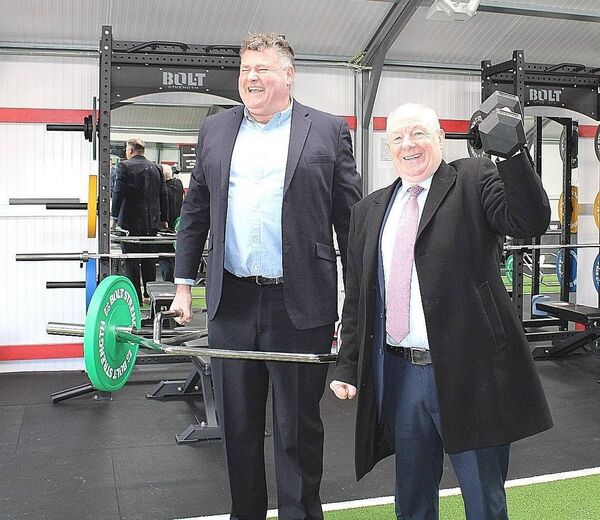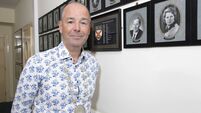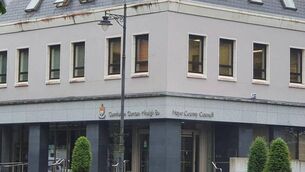Election 2024: Foxford's unbroken record is on the line once again

Foxford at the turn of the 20th century when Daniel Morrin became the town's first representative on Mayo County Council.
For a town of its size, Foxford has a remarkable record of representation in the chamber of Mayo County Council.
Since the council was established in 1899, Foxford has never failed to elect a locally-based councillor. It is an unbroken record that spans 25 elections in three different centuries, and it is all the more impressive when one considers that the neighbouring towns of Swinford and Kiltimagh have both been without a resident councillor at different stages in the past five years.
Similar-sized towns in West Mayo like Louisburgh and Newport also haven't had a resident councillor during the past decade. In the case of Newport, it's 15 years since Frank Chambers stood down and he has never been replaced; in fact, the town doesn't even have a candidate in this year's local elections. Louisburgh lost its seat in 2014 and failed to regain it in 2019 despite two local candidates polling a combined 1,729 first preferences.
The first Foxford man to be elected to Mayo County Council was Daniel Morrin, who owned a draper's shop a few doors up from the old courthouse on Upper Main Street. Morrin was aged 37 when he won the inaugural council election in 1899 in the Mountfalcon Electoral Area, of which Foxford was the principal town. He was returned in the elections of 1902, 1905, 1908, 1911 and 1914. All those elections were held under British rule.
The election of 1917 was postponed due to Britain's involvement in World War I, and by the time the next local elections were held in 1920, the political climate had changed completely in Ireland. Sinn Féin swept to power in uncontested polls that saw the party nominate councillors in each area. The man chosen to represent Foxford was John Judge, a building contractor who was active in the Irish independence movement.
Judge and the rest of his council colleagues spent their first year in office on the run, especially after October 1920 when an urban councillor in Galway City, Micheál Breathnach, was murdered by a British killing squad and his body dumped in the River Corrib. By early 1921, the majority of the 31 Mayo councillors were either in prison or on the run. Judge managed to evade capture by rarely sleeping at his home in Irishtown. When summer came, he slept in trees, sometimes near the railway station so he could keep an eye on British troop movements.
Judge resigned his seat in early 1922 once independence had been achieved. He went on to own a dancehall in Irishtown (on the site where Reape's workshop is now located) and fell out with the parish priest over the noise from the venue. The parish priest ordered him to shut it down but Judge refused, even after the Bishop of Achonry was contacted. There should be a statue in Foxford to Judge - the man who refused to bow to either the British Empire or the Bishop!
Judge was replaced on Mayo County Council by William Doherty, from Currinara, who had a distinguished record of military service from the War of Independence. He took the anti-Treaty side in the Civil War and, like Judge, spent much of his time on the run while serving as a councillor. Today, the Doherty family are renowned for their outstanding contribution to Irish traditional music. William's sister, Maggie, who died as a result of an atrocity committed during the Civil War, was fittingly commemorated last year in a fascinating and very moving RTE radio documentary.
Foxford also had a resident Sinn Féin TD in the early 1920s. Derry native Dr Frank Ferran, who was the local dispensary doctor, was elected to the second Dáil Éireann in May 1921 for the constituency of Sligo-Mayo East. He was re-elected as an anti-Treaty TD in 1922 and died while a political prisoner in the Curragh Camp in June 1923, aged 46.
On Monday next, June 3, at 3pm, a wreath will be laid at the old dispensary building in memory of Dr Ferran. Two of his grandnieces will be in attendance.
William Doherty held the council seat until 1925 when JJ Johnston was elected for Cumann na nGaedheal in the first local elections since independence. By now, Foxford was part of the larger Swinford Electoral District. Johnston owned a big retail business and was one of the founding members of the Foxford Brass Band.
The next election in 1928 saw Johnston replaced by Dr Mickie Hardy, representing the recently established Fianna Fáil. Dr Hardy was a very popular local GP who was re-elected in 1934 and held the seat for another eight years.
The local elections of 1942 saw the legendary Tommie O'Hara, from Coolegrane, succeed Dr Hardy as Foxford's representative on the council. O'Hara served continuously until 1974 and was also elected to Dáil Éireann for Clann na Talmhan in 1951 and 1954 and for Fine Gael in 1965 and 1969. He was re-elected to the council in 1945, 1950, 1955, 1960 and 1967.
Following O'Hara's retirement in 1974, party colleague Seán McEvoy, from Toomore, was elected in the local elections of that year and retained the seat in 1979, 1985 and 1991, serving a term as chairman of the council in 1992-'93, before bowing out in 1999.
The election of 1991 saw a second Foxford man, Fianna Fáil's Jimmy Maloney, also from Toomore, take a seat, which he held until 2014 when Fine Gael's Neil Cruise succeeded him. Jimmy also served a term as council chairman in 2001-'02 and was re-elected in 1999 (when he topped the poll), 2004 and 2009.

Neil Cruise retained the Foxford seat five years ago and increased his vote - despite changes in the electoral boundaries that saw him lose Knockmore. He will face another big challenge this time around to maintain Foxford's proud 125-year unbroken record on Mayo County Council, especially as Swinford and Kiltimagh are seeking to regain and retain their respective council seats in the four-seat Swinford Electoral Area, which stretches from Foxford to the Roscommon border.
* Don't miss Tuesday's Western People for extensive coverage of the upcoming Local and European Elections.




